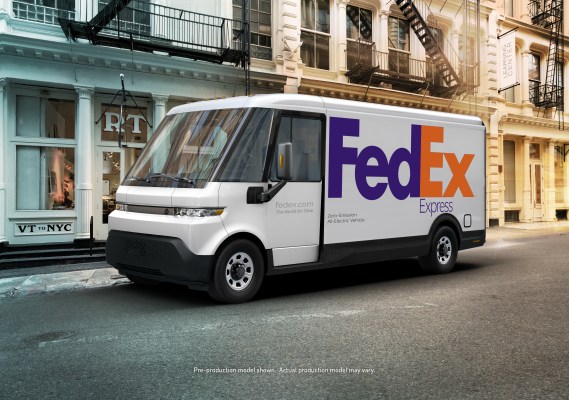General Motors’ commercial electric vehicle unit BrightDrop has scored Walmart as a customer with a reservation of 5,000 e-delivery vans to help the retail giant reach a zero-emissions logistics fleet by 2040, the company said on Wednesday at CES.
In addition, existing customer FedEx has reserved priority production for 2,000 vans over the next few years, upping its initial order of 500 EVs, which was announced at CES last year.
Walmart expects to receive a combination of EV600s, which are currently in production, and smaller EV410s, which will be available in late 2023, by next year. The vehicles will add to the company’s fleet of InHome delivery service vehicles, which the retailer announced would be expanding from around 6 million households today to 30 million U.S. homes by the end of 2022, as well as bolster its broader last-mile delivery network. Walmart will also deploy BrightDrop EVs for its GoLocal white-label delivery service geared toward third parties.
Walmart joins the lineup of big-name customers like Merchants Fleet and Verizon that are backing BrightDrop to help electrify their delivery fleets. In total, BrightDrop has upwards of 25,000 reservations, which doesn’t include the as-yet-unknown number of vehicles Verizon has ordered. FedEx, which received the first five of its order in Inglewood, California, last month, is considering adding 20,000 more EVs to its order in the coming years, pending a definitive purchase agreement.
As many companies look toward decarbonizing their transport to reach emissions goals, BrightDrop’s demand will only increase, but will it be able to scale from essentially zero to tens of thousands over the next couple of years?
“One of the unique things about how we’ve set up BrightDrop is that we’re marrying the best of both worlds where we set it up to run like a technology startup,” Travis Katz, president and CEO of BrightDrop, told TechCrunch. “We can move with speed, agility, and really focus on innovation and rapid cycles, but we’re marrying that setup with the manufacturing might of General Motors, and General Motors is just this amazing company when it comes to manufacturing at scale. When we open the doors next year at our Canadian factory, we will start producing these vehicles in large numbers and grow very quickly to meet the demand, and the demand for these vehicles is incredible.”
BrightDrop’s batteries will come from GM’s Ultium plant in Lordstown, Ohio, but the company aims to produce its vehicles at scale at a manufacturing plant in Ontario, Canada, which will begin production in the fourth quarter of the year. Until then, the company is relying on a low-volume production facility in Michigan run by one of its robotics suppliers, Kuka AG, so that it can go to market now.
“For FedEx specifically, the first vehicles were delivered last month [and] they are on the road delivering packages, and that first order of 500 we will be delivering to FedEx on a rolling basis,” Katz said at a press briefing on Tuesday. “We’re going to be sending more and more out to FedEx starting now, so you should expect to start to see those on the road, and if you live in the Los Angeles area to start having packages delivered to you with zero emissions in the months to come.”
FedEx also shared plans to expand its testing of BrightDrops EP1 electrified container to 10 markets this year. The companies just completed a second pilot program in New York City, which has already allowed the shipping and delivery company to increase package deliveries by 15% per hour, remove one on-road vehicle from its delivery route and cut curbside dwell time in half, according to BrightDrop. The first pilot, announced in January 2021, took place in Toronto and saw a 25% increase in package deliveries per day.
“By 2025, we’re planning for 50% of all FedEx Express global pickup and delivery vehicle purchases to be electric, rising to 100% of all new purchases by 2030,” FedEx Express regional president of the Americas and EVP Richard Smith said Tuesday. “We employ what we call a Goldilocks strategy for vehicle sizing, that small, medium and large vehicles with specific operational uses for each. BrightDrop’s current commercial EV portfolio with the EV410s and the EV600 can cover the small and medium-sized needs for FedEx. This means about two-thirds of the total pickup and delivery EV demand … could be sourced from BrightDrop, and we hope that they are, because the vehicles are tremendous. We’ve also talked to BrightDrop about the remaining one-third, which would require a larger vehicle with cargo space in excess of 1,000 cubic feet, and we’re hoping to work with them on that, as well.”
While FedEx’s new vehicles have already hit the streets of LA, Walmart’s will depend on where the company wants to start testing EVs and deployment, and where it’s already got charging infrastructure set up, Katz said. The retail company has also partnered with another GM subsidiary, autonomous vehicle company Cruise, to begin testing grocery delivery in Arizona.
“I think you can imagine when you have two companies with the same parent that overlap in these spaces, it unlocks a lot of potential and a lot of possibility,” said Katz. “And so I think, hopefully, we’ll have more to share about that in the future.”

